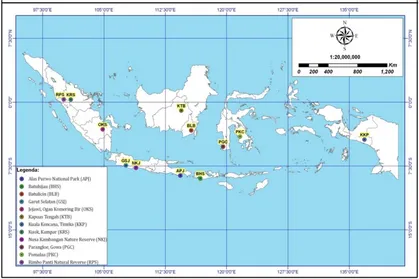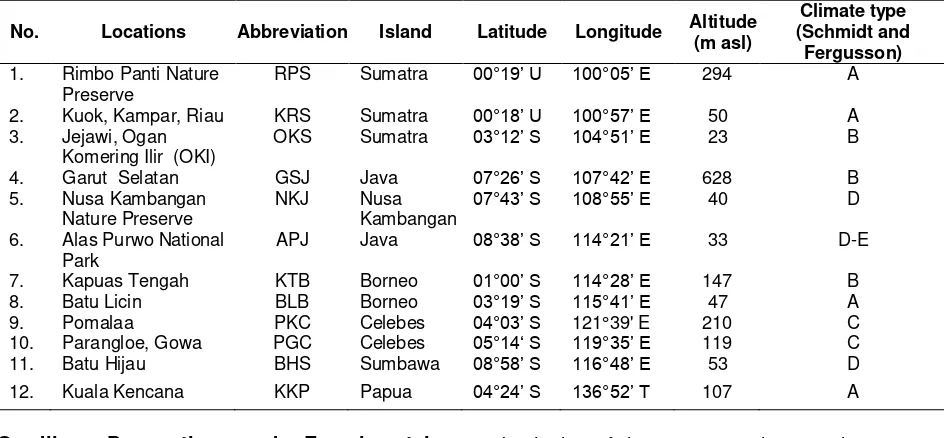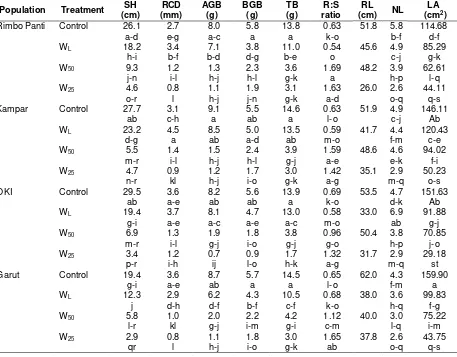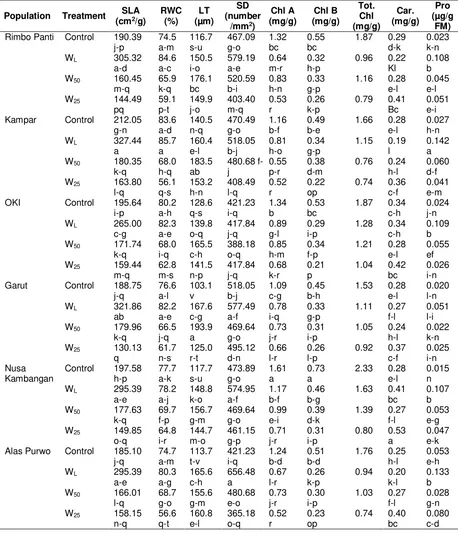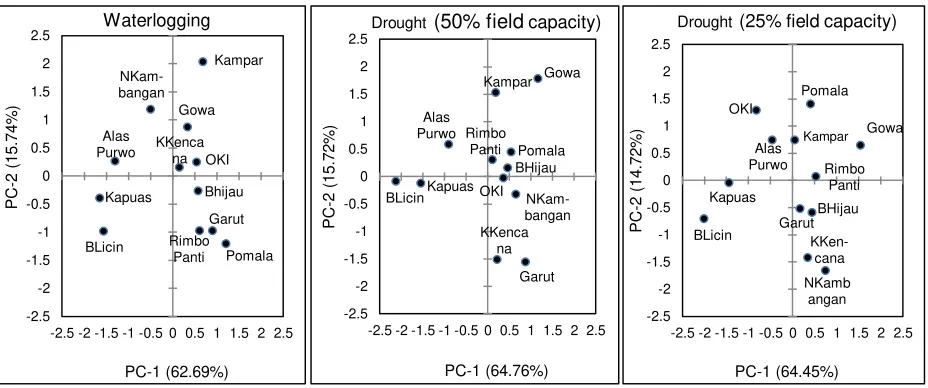ADAPTABILITY OF WHITE JABON (Anthocephalus cadamba Miq.) SEEDLING
FROM 12 POPULATIONS TO DROUGHT AND WATERLOGGING
Dede J. Sudrajat1*), Iskandar Z. Siregar2), Nurul Khumaida3), Ulfah J. Siregar2,4), and Irdika Mansur2,4) 1) Forest Tree Seed Technology Research Institute Forest Research and Development Agency
Jl. Pakuan Ciheuleut P.O. Box 105 Bogor West Java Indonesia 2) Department of Silviculture Bogor Agricultural University Jl. Lingkar Kampus IPB Darmaga-Bogor West Java Indonesia 3) Department of Agronomy and Horticulture, Bogor Agricultural University
Jl. Lingkar Kampus IPB Darmaga Bogor West Java Indonesia
4) Southeast Asian Regional Centre for Tropical Biology (SEAMEO-BIOTROP) Jl. Raya Tajur Km. 6 Bogor 16134 West Java Indonesia
*) Corresponding author E-mail: [email protected]
Received: September 9, 2014/ Accepted: May 15, 2015
ABSTRACT
The study was carried out for investigation of the adaptability of white jabon seedlings from 12 populations to drought and water logging stresses in a controlled green house. The results showed that the adaptive responses of white jabon seedling to drought and waterlogging stresses were affected by genotype (population). The drought and waterlogging stresses significantly inhibited plant growth, biomass accumulation and allocation, leaf area, also decreased chlorophyll content, increased carotenoids contents, and accumulated free proline. Relative water content and specific leaf area tended to be higher in waterlogging and declined in drought stresses. The result clearly indicated that white jabon seedlings were more adaptive to waterlogging than to drought stresses. Moreover, there were different responses to drought and waterlogging stresses between the twelve populations. Kampar, Gowa, Kuala Kencana and OKI populations exhibited higher growth performance and stress tolerance index to be adapted to waterlogging stress, while Gowa, Pomalaa and Kampar populations had relatively better growth performance in the drought stress.
Keywords: Anthocephalus cadamba, genotype, growth, population, stress tolerance index
INTRODUCTION
White jabon [Anthocephalus cadamba (Roxb.) Miq., family Rubiaceae] is a fast-growing tree
species that is native to Indonesia. It can be used for many purposes, such as the timber for pulp, plywood and light construction (Soerianegara and Lemmens, 1993), and various parts of the plant have bioactive compounds, including antioxidant, hypoglycemic, hypo-lipidemic, antibacterial and antimicrobial properties (Acharyya et al., 2011; Mishra and Siddique, 2011). This species grows widely in the tropical evergreen lowland rain forests of Asia, which extend through India, Nepal, Burma, Sri Lanka and Malaysia and across Indonesia, Philippines and New Guinea (Lamprecht, 1989). In Indonesia, the species is distributed on almost all islands and it plays an important role in both commercial and traditional farming systems in several areas of the country (Kallio et al., 2011; Irawan and Purwanto, 2014).
At present, white jabon is extensively planted in many types of sites, such as in wet and dry lands (Haneda et al., 2012), without considering of suitability of seed sources or populations, and in particular, so many planting activities are threatened by failure. Drought and water logging limit the potential range of many species by affecting seedling survival, growth and development potential of plants. They show significant effects in the initial stages of plant growth (e.g. during the first year of cultivation) (Kozlowski, 1997; Dunisch et al., 2003) and endanger plant survival. Some studies related to white jabon adaptations to water stresses showed that the species was not suitable for critical land rehabilitation (Voukko and Otsamo, 1996), not optimal growth at low soil field capacity
Accredited SK No.: 81/DIKTI/Kep/2011
(Soetrisno, 1996) and also in shallow water table soil (Mansur and Suharman, 2011).
Drought and waterlogging stresses in several Indonesian areas were predicted to increase due to climate change (Policy Synthetic Team, 2008) and it is potential to increase an adverse effect to initial seedling growth and succes of forest and land rehabilitation activities. To promote the successful curent-year tree seedlings settlement, especially in waterloogging and drought land, the key to understand is how they are adapted to drought and waterlogging, a critical condition for silviculture activities of white jabon. However, very little of knowledge is known about inter-population variation in adaptability to the stresses in white jabon. Assessment of populationsfrom several geography ranges is important to select the adapted genotype to drought and waterlogging stresses, because some studies reported that several populations naturally often found in the transitional zone between swampy, permanently flooded areas and periodically flooded areas and it is also found in drier areas with low annual rainfalls (Soerianegara and Lemmens, 1993). Comprehensive knowledge about provenance responses on
drought and waterlogging can become a reference in development of seed transfer guideline (Wang et al., 1989), selection of adaptive provenances, and also as a key of adaptation strategy on climate change (Millar et al., 2007). The objective of this study was to investigate the adaptability of white jabon seedlings from the twelve populations to drought and water logging stresses in a controlled greenhouse.
MATERIALS AND METHODS
Sample Collection
White jabon seeds were collected from 12 populations distributed in 7 islands in Indonesia (Figure 1, Table 1). The seeds were collected from 10 - 20 dominant trees per population and a minimum distance of 50 m on average was maintained between each seed tree to prevent sampling trees from the same parent or pedigree. The seeds from individual trees were equally sampled by weight and bulked by population for the experiment.
Table 1.Geographic origin of the investigated population
No. Locations Abbreviation Island Latitude Longitude Altitude (m asl)
Climate type (Schmidt and
Fergusson)
1. Rimbo Panti Nature Preserve
RPS Sumatra 00°19’ U 100°05’ E 294 A
2. Kuok, Kampar, Riau KRS Sumatra 00°18’ U 100°57’ E 50 A
3. Jejawi, Ogan Komering Ilir (OKI)
OKS Sumatra 03°12’ S 104°51’ E 23 B
4. Garut Selatan GSJ Java 07°26’ S 107°42’ E 628 B
5. Nusa Kambangan Nature Preserve
NKJ Nusa
Kambangan 07°43’ S 108°55’ E
40 D
6. Alas Purwo National Park
APJ Java 08°38’ S 114°21’ E 33 D-E
7. Kapuas Tengah KTB Borneo 01°00’ S 114°28’ E 147 B
8. Batu Licin BLB Borneo 03°19’ S 115°41’ E 47 A
9. Pomalaa PKC Celebes 04°03’ S 121°39' E 210 C
10. Parangloe, Gowa PGC Celebes 05°14‘ S 119°35’ E 119 C
11. Batu Hijau BHS Sumbawa 08°58’ S 116°48’ E 53 D
12. Kuala Kencana KKP Papua 04°24’ S 136°52’ T 107 A
Seedling Preparation and Experimental Design
White jabon seedlings were tested in a controlled condition in the green house to identify their adaptability on different water stress conditions. For each population, 10 normal seedlings (± 3 cm in height) are randomly taken from sowing boxes and planted in pots (18.5 cm in diameter x 16 cm in height). There were 40 pots planted by seedling for each population. On the early stage of growing, seedlings were placed in an optimal condition in nursery. After 2 months, the seedlings were moved to the greenhouse. During the experiment, the average day and night temperatures in the greenhouse were 34°C and 29°C, respectively, and the relative humidity ranged from 60 to 75%. The treatments of water stress condition were done after 1 month seedling in the green house.
A completely randomized design was used with factorial combinations of water stress [well-water supply (control), 3-5 cm-[well-water logging (WL), watered every 2 days with 50% field capacity (W50) and 25% field capacity (W25)] and white jabon populations (12 populations). A pot was the experimental unit and each treatment was replicated 10 times; thus, there were a total of 40 seedlings per populations. The soil volumetric water content for control and drought treatments was maintained at 32.8 ± 2.8%, 25.3 ± 0.7%, and 19.8 ± 1.4% for the control, W50, and W25 treatments, respectively. 120 days after the
beginning of the treatment, the experiment was terminated.
Measurement of Seedling Growth Characteristics and Biomass Production
Height and root collar diameter of seedlings were recorded at prior to the experiment and at the end of the experiment. The growth of height and diameter was resulted from reduction of the final measurement with the first measurement. At the end of the drought and water logging regime, all plants were measured for leaf area, number of leaf, biomass, root length, adventitious roots and lenticels. For biomass measurements, all plants were harvested and divided into roots, stems and leaves. Roots, stems and leaves were dried separately in a drying oven at 70°C for 48 h and weighed to ±0.0001 g. Leaves and stems were aggregated and are subsequently referred to as above-ground biomass and roots are referred to as below-ground biomass. Total biomass is the sum of above-ground and below-ground biomass. Root-shoot ratio and specific leaf area was calculated using the following formula Li et al. (2011).
Measurement of Relative Water Content, Stomatal Density and Leaf Thickness
thickness measurements. Relative water content was determined gravimetrically on the selected leaves from the mid-canopy position following method of Li et al. (2011). Stomatal density was measured using a nail polish impression of the abaxial surface of the first fully developed leaf harvested at the end of the treatments and counted under a light microscope in three random fields per leaf at ×40 magnification. For leaf thickness measurements, three slides were prepared for each leaf. A cryotome was used to cut cross-sections that were adhered to slides. Digital images were taken of each slide at x40 magnification with a digital still camera in conjunction with a microscope (Olympus L15643). Analysis of Pigments and Proline Contents
The concentrations of chlorophyll A, chlorophyll B, total chlorophyll, carotenoids, and proline were measured from a single leaf at the second pair from the apices of the three randomly seedlings. The total chlorophyll and carotenoids were determined using the method described by Lichtenthaler (1987) using a Shimadzu UV-1201 spectrophotometer, while the free proline content was measured according to the method of Bates et al. (1973) using Hitachi U-3900H spectro-photometer.
Statistical Analysis
The data were analyzed with ANOVA to test the effect on the water stress and populations on the seedling morphological, anatomical and physiological variables. Duncan’s multiple range test at a significance level p<0.05 was used to compare significant differences in the means. The statistical analysis was performed employing SAS 9.1 for windows. Stress tolerance index was analyzed on the growth parameters (height, diameter and total biomass) using formula of Fernandez (1992). Principal component analysis was used to explain the pattern of adaptation variation among the populations based on seedling morphological characteristics.
RESULT AND DISCUSSION
Growth Characteristics and Biomass Production Drought stresses caused significant growth decline in seedling height, root collar diameter, above-ground biomass, below-ground biomass, total biomass, root length and leaf area of white jabon seedlings, except of root shoot
ratio, showing the significant increase on drought stress (Table 2). Similar results of drought responses on the growth characteristics have been reported in several previous studies (Yang and Miao, 2010; Ky-Dembele et al., 2010). Water deficits reduce the number of leaves per plant, and individual leaf size, and leaf longevity by
decreasing the soil’s water potential. Generally,
when water availability is limited, the root-shoot ratio of plants increases because roots become less sensitive than shoots to growth inhibitor that is low water potentials (Li et al., 2011).
In waterlogging stress, height, biomass accumulations, root length and leaf area also were reduced compared to the control. On the contrary, the root-shoot ratio and root collar diameter in the waterlogging treatment were higher than in the other treatments. The similar result also occurred in waterlogged seedlings of Carex lasiocarpa and C. limosa (Lu, 2011). According to Kozlowski (1997), waterlogging often affects xylem and phloem production. Waterlogged soils increased stem diameter growth more as a result of increasing bark thickening and stem hypertrophy, which then cause xylem increment. The increase in bark thickness was associated with accelerated proliferation of phloem parenchyma cells and large amounts of intercellular space in the phloem (Yamamoto and Kozlowski, 1987).
regarded as one of important indexes in plant tolerance (Mommer et al., 2006).
Waterlogging stress also emerged adventives root and hypertrophied lenticels that were not found in other treatments. The production of adventives root and lenticels on the submerged portions of stems in waterlogged seedlings has been described as a morpho-logically adaptive mechanism against the waterlogged sites (Yamamoto et al., 1995; Glenz et al., 2006) to increase the uptake of O2 by aerial tissues and promotes its transport into the root system (Konzlowski, 1997; Glens et al., 2006).
The adventives root is very important for plants under root hypoxia or anoxia to obtain oxygen from the environment because it may directly get oxygen from the surroundings and internally transport oxygen through aerenchyma. Further-more, the ability to produce adventives root is commonly associated with enhanced tolerance to waterlogging (Steffens et al., 2006). Kampar population had more amounts of adventives root and lenticels than the other populations indicating the population that is more adaptive to waterlogged sites.
Table 2. Seedling height, root collar diameter, biomass accumulation, root-stem ratio, root length, number of leaf and leaf area of white jabon seedling under four water treatments
Table 2. (Continued)
Population Treatment SH (cm)
Remarks: SH=height increment, RCD=root collar diameter increment, ABG=above-ground biomass, BGB=below-ground biomass, TB=total biomass, R:S ratio = root-shoot ratio, RL = root length, NL = number of leaf, LA = leaf area. WL = waterlogging, W50 = field capacity 50%, and W25 = field capacity 25%. Different letters within
a column indicate significant differences at P < 0.05. ** = significant at 1%, *= significant at 5%, ns= non significant.
Figure 2. Number of adventive root and lenticels of each population in the waterlogging treatment
Specific Leaf Area, Relative Water Content and Leaf Thickness
Specific leaf area and relative water content was different for treatment and population, being highest in the WL treatment and the lowest in the W25 treatment. Specific leaf area and relative water content are considered as measurement of water status, reflecting the metabolic activity in tissue and used as the most meaningful index for dehydration tolerance (Anjum et al., 2011). In the waterlogging treatment, Kampar population had the highest specific leaf area and relative water content, whereas in the drought (W25) stress, Gowa population had the highest specific leaf area and relative water content (Table 3).
The leaf thickness had the trend to increase in response to water stress from the control, water logging, moderate drought (W50) and severe drought stress (W25) treatments. Plants growing in stress conditions usually have thicker leaves than those growing in wet conditions (Kofidis et al., 2004; Guerfel et al., 2009). Small and thicker leaves can withstand turgor pressure better than large and thinner leaves, and they can contribute to turgor maintenance more effectively under stress conditions. Gowa population had the thickest leaf and could be considered as a more adaptive population to drought stress.
Stomatal Density, Pigments and Proline Contents
Interaction of water stress treatment and population effects were significant for stomatal density that declined following the reduction of soil water content (Table 3). Most of the populations had the highest stomatal density in the WL treatment, while the lowest stomatal density was shown by the W25 treatment. According to Sciutti and Morini (1995) concerning with air humidity, increased air humidity results in increased stomatal density. More stomata can take up more CO2 and transpire more water. The mechanisms of water loss control through stomata (transpiration) seem to be an efficient process to maintain leaf turgor under drought condition. Gowa population had the lowest stomatal density in the drought stress (W25) and transpired less water so more adaptive to drought stress.
The concentrations of chlorophyll A and chlorophyll B were initially different among populations. Increasing water stress, both drought
and waterlogging significantly reduced the chlorophyll A and chlorophyll B. Conversely, carotenoids under severe drought tended to increase. The change in chlorophyll and carotenoids contents has been used to evaluate the influence of environmental stress on plant growth, and earlier study proved that chlorophyll contents usually decreased under drought (Singh and Reddy, 2011) and waterlogging stress (Xiaoling et al., 2011) due to their slow synthesis or fast breakdown (Amini et al., 2013; Sayyari et al., 2013), instability of protein complexes and destruction of chlorophyll by increased activity of chlorophyll degrading enzymes and chloro-phyllase under stress condition (Nunes et al., 2008). On the other hand, the carotenoids contents tended to decrease under waterlogging and moderate drought (W50) stresses, but slightly increase under severe drought stress (W25). Increase of carotenoids content was also reported in drought stressed Campylotropics polyantha (Li et al., 2011). Carotenoids have essential functions in photosynthesis and photo-protection. Besides their structural roles, they are well known for their antioxidant activity, inhibiting lipid peroxidation and stabilizing membranes.
Table 3. Specific leaf area, relative water content, leaf thickness, stomatal density, pigments, and proline contents of white jabon seedling under four water treatments
Population Treatment SLA (cm2/g)
Rimbo Panti Control 190.39 j-p
Kampar Control 212.05
g-n
Control 197.58 h-p Alas Purwo Control 185.10
Table 3. (Continued)
Population Treatment SLA (cm2/g)
Kapuas Control 197.33
h-p Batu Licin Control 204.51
h-o
Pomalaa Control 220.78
f-l Batu Hijau Control 175.56
k-q
Control 219.17 g-l Remarks: SLA=specific leaf area, RWC=relative water content, LT=leaf thickness, SD = stomatal density, Chl A = chlorophyll
A, Chl B = chlorophyll B, Tot Chl = total chlorophyll, Car = carotenoids, Pro = proline. WL = waterlogging, W50 = field
capacity 50%, and W25 = field capacity 25%. Different letters within the column indicate significant differences at P
Table 4. Evaluation of tolerance indices of 12 white jabon populations to drought and waterlogging stress
Population
Treatments
Waterlogging 50% field capacity 25% field capacity
SH RCD TB SH RCD TB SH RCD TB
Rimbo Panti 0.95 0.82 1.04 0.48 0.27 0.34 0.24 0.17 0.29
Kampar 1.29 1.29 1.32 0.40 0.42 0.38 0.26 0.27 0.29
OKI 1.14 1.21 1.22 0.41 0.29 0.36 0.20 0.28 0.16
Garut 0.48 0.95 1.04 0.23 0.23 0.42 0.11 0.19 0.30
Nusa Kambangan 1.01 1.38 0.51 0.44 0.37 0.22 0.19 0.28 0.19
Alas Purwo 0.43 0.99 0.32 0.23 0.28 0.20 0.13 0.15 0.17
Kapuas 0.16 0.76 0.11 0.07 0.23 0.04 0.05 0.17 0.03
Batu Hijau 0.14 0.61 0.09 0.06 0.18 0.04 0.05 0.15 0.02
Gowa 1.12 1.71 1.27 0.49 0.66 0.55 0.41 0.35 0.45
Pomalaa 0.77 1.23 1.30 0.29 0.39 0.34 0.20 0.23 0.30
Batu Hijau 0.82 1.37 1.22 0.22 0.32 0.44 0.19 0.29 0.30
Kuala Kencana 1.25 1.74 1.00 0.47 0.29 0.32 0.31 0.26 0.25
Remarks: SH= seedling height, RCD=root collar diameter, TB=total biomass.
Figure 3. Biplot of seedling adaptability of white jabon from 12 populations to drought and waterlogging based on seedling morphophysiological characteristics
Stress Tolerance Index and Clustering of Population Adaptability
Population with high stress tolerance index (STI) had better adaptability to stress. The highest STI in the WL treatment was indicated by Kampar population (seedling height and total biomass) and Kuala Kencana population (root collar diameter). In the W50 and W25 treatments, Gowa population had the highest STI. Kampar population had the highest STI in height and total biomass (Table 4). STI can be used to identify genotypes that produce high growth and biomass under both stress and non-stress conditions (Fernandez, 1992) so the higher STI showed the better adaptability of the
genotype (Olaoye et al., 2009). Gowa population had highest STI in height, root collar diameter and total biomass indicating Gowa population was more adaptive to drought stress than the other populations.
The trend of STI is similar with biplot graphical of principal component analysis for clustering of seedling adaptation. Some populations were identified more tolerant to waterlogging stress such as Kampar, Gowa, Kuala Kencana and OKI. Based on STI, all of the white jabon population is not tolerant to drought stress, and more adaptive to waterlogging. Adaptability of white jabon seedlings to waterlogging is correlated
Rimbo Panti
Kampar
Garut OKI NKam-bangan
Alas Purwo
Kapuas
BLicin
Gowa
Pomala Bhijau KKenca
na
-2.5 -2 -1.5 -1 -0.5 0 0.5 1 1.5 2 2.5
-2.5 -2 -1.5 -1 -0.5 0 0.5 1 1.5 2 2.5
PC
-2
(1
5
.7
4
%
)
PC-1 (62.69%)
Waterlogging
Rimbo Panti
Kampar
OKI
Garut BHijau Alas
Purwo
Kapuas BLicin
Gowa
Pomala
NKam-bangan KKenca
na
-2.5 -2 -1.5 -1 -0.5 0 0.5 1 1.5 2 2.5
-2.5 -2 -1.5 -1 -0.5 0 0.5 1 1.5 2 2.5
PC
-2
(1
5
.7
2
%
)
PC-1 (64.76%) Drought (50% field capacity)
BHijau
Kampar
OKI
Garut Pomala
Alas Purwo
Kapuas
BLicin
Gowa
Rimbo Panti
NKamb angan
KKen-cana
-2.5 -2 -1.5 -1 -0.5 0 0.5 1 1.5 2 2.5
-2.5 -2 -1.5 -1 -0.5 0 0.5 1 1.5 2 2.5
PC
-2
(1
4
.7
2
%
)
with natural habitats of jabon, generally distributed on the deep, moist, and alluvial sites and vice versa, the general condition of the natural habitat also affected the adaptation of seedlings that is less adapted to drought stress. However considering the seedling growth, survival and biplot from principal component analysis, some populations were more adaptive to drought stress, i.e. Gowa, Pomalaa, and Kampar populations. The identified populations are more potential to be transferred and planted in the marginal sites especially in drought and waterlogged areas.
CONCLUSION
White jabon seedlings were more tolerant to waterlogging than drought stress, which can be observed from morphological, physiological and anatomical traits, and the absence of seedling under the waterlogging treatment that died during the experiment. In order to cope with water stress, the following was conducted by avoidance mechanism achieved through morphological changes (leaf morphology, adventives root, lenticels) and also by tolerance mechanism achieved by cell and tissue specific physiology, biochemistry (chlorophyll and carotenoids), and accumulation of proline. From several indicators of morphology, physiology, and biochemistry, Kampar, Gowa, Kuala Kencana, and OKI populations were indicated as the populations which were able to be well adapted to the waterlogging stress, and the populations can be used for rehabilitation activities of waterlogged marginal sites. In the drought stress, Gowa, Pomalaa, and Kampar populations had relatively better performance than the other populations, and the populations can be used for replanting the dryer marginal sites.
ACKNOWLEDGEMENTS
The authors wish to acknowledge SEAMEO-BIOTROP, Bogor, Indonesia for their financial assistance under a research grant No. 047.20/PSRP/ST-PNLT/III/2012.
REFERENCES
Acharyya, S., D.S. Rathore, H.K.S. Kumar, and N. Panda. 2011. Screening of Anthoce-phalus cadamba (Roxb.) Miq. root for antimicrobial and anthelmintic activities.
Int. J. Res. Pharmac. Biomed. Sci. 2 (1): 297-300.
Amini, R., M.A. Milani, and A.D. Mohammadinasab. 2013. Physiological response of lentil (Lens culinaris Medick.) to water limitation affected by wheat straw mulch application. Int. J. Agron. Plant Prod. 4 (10): 2548-2553.
Anjum, S.A., X. Xie, L. Wang, M.F. Saleem, C. Man, and W. Lei. 2011. Morphological, physiological and biochemical responses of plants to drought stress. Afric. J. Agric. Res. 6 (9): 2026-2032.
Bates, L.S., R.P. Waldren, and I.D. Teare. 1973. Rapid determination of free proline for water stress studies. Plant and Soil 39 (1): 205-207.
Cordeiro, Y.E.M., H.A. Pinheiro, B.G.d.S. Filho, S.S. Correa, J.R.R. Silva, and M.B. Dias-Filho. 2009. Physiological and morpho-logical responses of young mahogany (Swietenia macrophylla King) plants to drought. For. Ecol. Manag. 258: 1449-1455.
Dunisch, O., M. Erbreich, and T. Eilers. 2003. Water balance and water potentials of a monoculture and an enrichment plantation of Carapa guianensis Aubl. in the Central Amazon. For. Ecol. Manag. 172 (2-3): 355–367.
Farooq, M., A. Wahid, N. Kobayashi, D. Fujita, and S.M.A. Basra. 2009. Plant drought stress: effects, mechanisms and manage-ment. Agron. Sustain. Dev. 29(1): 185-212.
Fernandez, G.C.J. 1992. Effective selection criteria for assessing plant stress tolerance. In: Kuo C.G. (Ed.) Proceedings of the international symposium on adaptation of vegetables and other food crops in temperature and water stress. Taiwan. p. 257-270.
Glenz, C., R. Schlaepfer, I. Iorgulescu, and F. Kienast. 2006. Flooding tolerance of Central European tree and shrub species. For. Ecol. Manag. 235: 1-13. Guerfel, M., O. Baccouri, D. Boujnah, W. Chaibi,
Haneda, N.F., S.W.B. Raharjo, T. Tiryana, J.W. Seo, and S.C. Susanty. 2012. Inventory of silvicultural practices, growth and pests of jabon planted for community forestry. Research report of SEAMEO-BIOTROP. Bogor. pp. 45.
Ibrahim, A.H. 2013. Tolerance and avoidance responses to salinity and water stresses in Calotropis procera and Suaeda aegyptiaca. Turki. J. Agric. For. 37 (3): 352-360.
Irawan, U.S., and E. Purwanto. 2014.White jabon (Anthocephalus cadamba) and red jabon (Anthocephalus macrophyllus) for community land rehabilitation: Improving local propagation efforts. Agric. Sci. 2(3): 36-45.
Kallio, M.H., H. Krisnawati, D. Rohadi, and M. Kanninen. 2011. Mahogany and kadam planting farmers in South Kalimantan: The link between silvicultural activity and stand quality. Smallscale Forestry 10 (1): 115-132.
Kofidis, G., A.M. Bosabalidis, and K. Chartzoulakis. 2004. Leaf anatomical alterations induced by drought stress in two avocado cultivars. J. Biol. Res. 1: 115-120.
Kozlowski, T.T. 1997. Responses of woody plants to flooding and salinity. Tree Physiol. Monogr. 1: 1-29.
Ky-Dembele, C., J. Bayala, P. Savadogo, M. Tigabu, P.C. Odén, and I.J. Boussim. 2010. Comparison of growth responses of Khaya senegalensis seedlings and stecklings to four irrigation regimes. Silva Fenn. 44 (5): 787-798.
Lamprecht, H. 1989. Silviculture in the tropics; Tropical forest ecosystems and their tree species – Possibilities and methods for their long-term utilization. Eschborn (DE): Deutsche Gesellschaft fur Technische Zusammenarbeit (GTZ).
Li, F.L., W.K. Bao, and N. Wu. 2011. Morphological, anatomical and physio-logical responses of Campylotropis polyantha (Franch.) Schindl. seedlings to progressive water stress. Sci. Hortic. 127: 436-443.
Lichtenthaler, H.K. 1987. Chlorophylls and carotenoids: pigments of photosynthetic biomembranes. Methods Enzymol. 148: 350–382.
Lu, Y. 2011. Growth and morphological responses to water level variations in two Carex species from Sanjiang Plain, China. Afr. J. Agric. Res. 6 (1): 28-34. Mansur, I. and Surahman. 2011. The growth of
jabon (Anthocephalus cadamba) in less optimum environment and Its respons to fertilizer application. J. Silvic. Trop. 3 (1): 71-77. (in Indonesian)
Millar, C.I., N.L. Stephenson, and S.L.Stephens. 2007. Climate change and forests of the future: managing in the face of uncertainty. Ecol. Appl. 17 (8): 2145-2151. Mishra, R.P. and L.Siddique. 2011. Antibacterial
properties of Anthocephalus cadamba fruits. Asian J. Plant Sci. Res. 1 (2): 1-7. Mommer, L., J.P.M. Lenssen, H. Huber, E.J.W.
Visser, and H.D. Kroon. 2006. Eco-physiological determinants of plants performance under flooding: a comparative study of seven plant families. J. Ecol. 94 (6): 1117-1129.
Nunes, C., S.S. Araujo, J.M. Silva, M.P.S. Fevereiro, and A.B.d. Silva. 2008. Physio-logical responses of the legume model Medicago truncatula cv. jemalong to water deficit. Environ. Exp. Bot. 63: 289-296. Olaoye, G., A. Menkir, S.O. Ajala, and S. Jacob.
2009. Evaluation of local maize (Zea mays L.) varieties from Burkina Faso as source of tolerance to drought. J. Appl. Biosci. 17: 887-898.
Policy Synthetic Team. 2008. Impact of climate change on agricultural sector, and anti-cipation strategy and adaptation technology. J. Agric. Inov. Develop. 1 (2): 138-140. (in Indonesian)
Sayyari, M., M. Ghavami, F. Ghanbari, and S. Kordi. 2013. Assessment of salicylic acid impacts on growth rate and some physiological parameters of lettuce plants under drought stress conditions. Int. J. Agric. Crop Sci. 5 (17):1951-1957. Sciutti, R. and S. Morini. 1995. Water-loss and photosynthesis of plum plantlets is influenced by relative-humidity during rooting in-vitro. J. Hortic. Sci. Biotech. 70 (2): 221-228.
under drought. J. Photoch. Photobio. B. 105 (1): 40-50.
Soerianegara, I. and R.H.M.J. Lemmens. 1993. Plant resources of South-east Asia 5 (1): Timber trees: Major commercial timbers. Pudoc Scientific Publishers, Wageningen, Netherlands.
Soetrisno, K. 1996. Effect of soil water content on the growth of jabon (Anthocephalus cadamba Miq) seedling. Frontir 18: 99-109. (in Indonesian)
Steffens, B., J. Wang, and M. Sauter. 2006. Interactions between ethylene, giberellin and abcisic acid regulate emergence and growth rate of adventitious roots in deepwater rice. Planta 233 (3): 604-612. Vuokko, R. and A. Otsamo. 1996. Species and
population selection for plantation forestry on grassland. In Reforestation: Meeting the future industrial wood demand. Proceedings of a workshop held in Jakarta, 30 April-1 May 1996. Ministry of Forestry and Enso Forest Development Oy Ltd. Jakarta.
Wang, J.R., C.D.B. Hawkins, and T. Letchford. 1998. Photosynthesis, water and nitrogen use efficiencies of four paper birch (Betula
papyrifera) populations grown under different soil moisture and nutrient regimes. Forest. Ecol. Manag.112: 233-244.
Xiaoling, L., L. Ning, Y. Jin, Y. Fuzhou, C. Faju, and C. Fangqing. 2011. Morphological and photosynthetic responses of riparian plant Distylium chinense seedlings to simulated autumn and winter flooding in three gorges reservoir region of the Yangtze River, China. Acta Ecol. Sin. 31:31-39.
Yamamoto, F. and T.T. Kozlowski. 1987. Effect of flooding, tilting of stems and ethrel application on growth, stem anatomy and ethylene production of Pinus densiflora seedlings. J. Exp. Bot. 38 (2): 293-310. Yamamoto, F., S. Sakata and K. Tenazawa.
1995. Physiological, morphological and anatomical responses of Fraxinus mandshurica seedlings to flooding. Tree Physiol. 15: 713-719.
